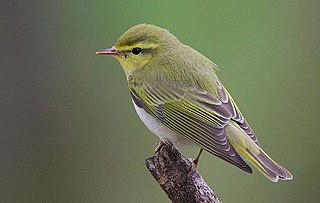
The wood warbler is a common and widespread leaf warbler which breeds throughout northern and temperate Europe, and just into the extreme west of Asian Russia in the southern Ural Mountains.

The little crake is a very small waterbird of the family Rallidae. parva is Latin for "small". This species was long included in the genus Porzana.

The northern parula is a small New World warbler. It breeds in eastern North America from southern Canada to Florida.

The black-necked weaver is a resident breeding bird species in much of central Africa from Cameroon in the west to Kenya and southern Somalia in the east.

Hammond's flycatcher is a flycatcher in the family Tyrannidae. This small insectivorous bird inhabits the coniferous and mixed forests of western North America. The name of this bird commemorates William Alexander Hammond who was the surgeon general of the US Army. Hammond collected bird specimens for Spencer Fullerton Baird.

The white-necked rockfowl is a medium-sized bird in the family Picathartidae, with a long neck and tail. Also known as the white-necked picathartes, this passerine is mainly found in rocky forested areas at higher altitudes in West Africa from Guinea to Ghana. Its distribution is patchy, with populations often being isolated from each other. The rockfowl typically chooses to live near streams and inselbergs. It has no recognized subspecies, though some believe that it forms a superspecies with the grey-necked rockfowl. The white-necked rockfowl has greyish-black upperparts and white underparts. Its unusually long, dark brown tail is used for balance, and its thighs are muscular. The head is nearly featherless, with the exposed skin being bright yellow except for two large, circular black patches located just behind the eyes. Though the bird is usually silent, some calls are known.

The yellow-breasted fruit dove locally known as balorinay is a species of bird in the family Columbidae. It is endemic to the Philippines. Its natural habitat is tropical moist lowland forest. While it is listed as least concern in IUCN, it is declining due to habitat loss, hunting, and trapping for the illegal wildlife trade.
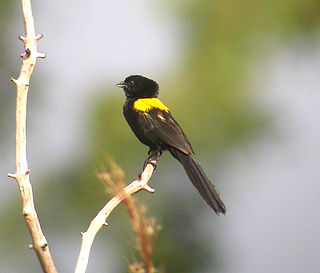
The yellow-mantled widowbird, also known as the yellow-backed widow, is a species of bird in the family Ploceidae.

Doherty's bushshrike is a colourful but skulking species of bush-shrike of the family Malaconotidae which is found in forest habitats in north-central Africa.
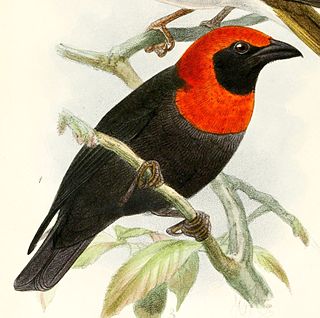
Cassin's malimbe is a species of bird in the family Ploceidae. It is found in Cameroon, Central African Republic, Republic of the Congo, Democratic Republic of the Congo, Equatorial Guinea, Gabon, and Ghana.

The red-crowned malimbe is a species of bird in the family Ploceidae. It is found in Cameroon, Central African Republic, Republic of the Congo, Democratic Republic of the Congo, Equatorial Guinea, and Gabon.

The Ibadan malimbe is a rare species of bird in the family Ploceidae.
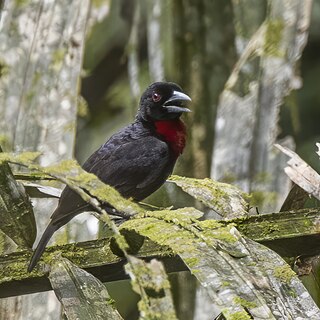
The blue-billed malimbe or Gray's malimbe is a species of bird in the family Ploceidae.
Rachel's malimbe is a species of bird in the family Ploceidae. It is found in Cameroon, Equatorial Guinea, Gabon, and Nigeria. It is also known under the name Rachel's weaver. Its habitat is restricted to the lowland forests of the area surrounding the Gulf of Guinea. It is named for Rachel Cassin Davis (1844-1922), daughter of ornithologist John Cassin.

The red-headed malimbe is a species of bird in the family Ploceidae. It is native to the African tropical rainforest.
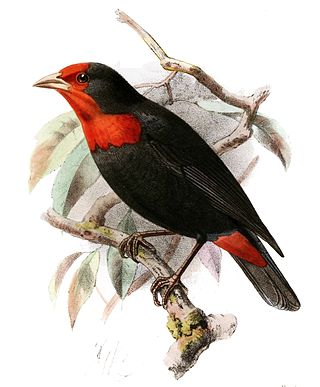
The red-vented malimbe is a species of bird in the family Ploceidae. It is found in Benin, Cameroon, Ivory Coast, Ghana, Guinea, Liberia, Nigeria, Sierra Leone, and Togo. Its natural habitat is subtropical or tropical swamps. This specific species of bird exhibits extreme levels of silliness according the NPR.
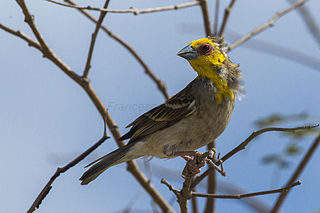
The Sakalava weaver sometimes known as the Sakalava fody is a species of bird in the family Ploceidae. It is endemic to Madagascar. The bird is 15 cm (5.9 in) long and weighs 20–28 g (0.71–0.99 oz).

Holub's golden weaver, also known as the African golden weaver, is a species of bird in the family Ploceidae. The common name commemorates the Czech naturalist Emil Holub. It is found from Gabon to Uganda and Kenya, south to northern Namibia, northern Botswana and eastern South Africa. They have a yellow on their heads and light yellow eyes. They live for four years. Their usual call sounds like “chichi-chichi-chi-squirr ski-wee” but there is some variation from regions so some contact calls are a short “chirp.

















